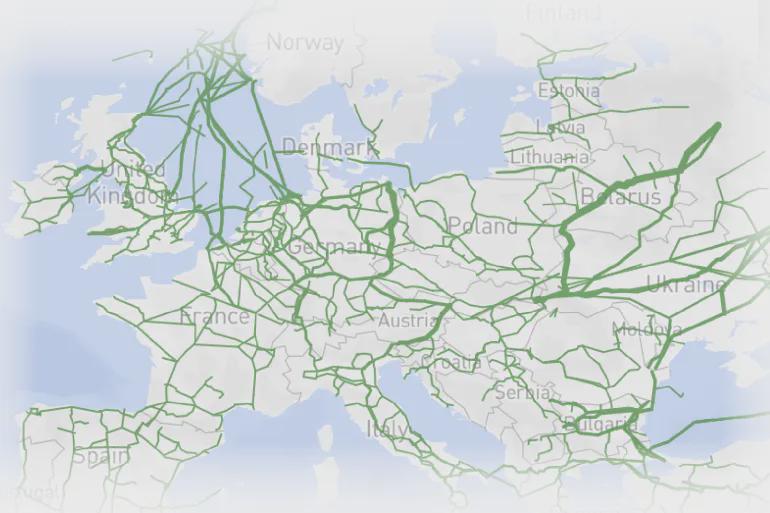EU Energy Reliance on Russia Map


David Chen
Data Visualization Specialist
David Chen is an expert in transforming complex geographic datasets into compelling visual narratives. He combines his background in computer science ...
Geographic Analysis
What This Map Shows
The map titled "EU cut Russian energy reliance: gas 45→19%, oil 27→3%, Hungary/Slovakia still dependent" visually represents the significant changes in energy imports from Russia to the European Union. It highlights the drastic reduction in reliance on Russian gas and oil, showcasing a shift from 45% to 19% for gas and an even more striking decrease for oil from 27% to a mere 3%. However, what stands out is the continued dependency of Hungary and Slovakia, which suggests a complex interplay of energy security and geopolitical relationships in the region.
Transitioning from the visualization, let’s delve deeper into the broader implications of energy reliance, particularly focusing on natural gas and oil and their pivotal role in the EU's energy strategy.
Deep Dive into European Energy Dependency
Energy dependency is a critical issue not just for economic stability but also for national security and environmental policy. The European Union’s reliance on Russian energy has been a topic of heated discussion, particularly in light of geopolitical tensions. Historically, Russia has been a major supplier of natural gas and oil to the EU, making up a substantial portion of the energy mix across member states.
Natural gas, in particular, is vital for heating homes, powering industries, and generating electricity. The EU's dependency on Russian gas reached an alarming peak of 45%, a figure that has now been slashed to 19%. This dramatic reduction is a response to the urgent need for energy diversification, especially after the conflict in Ukraine heightened concerns about energy security. Interestingly, the EU has been actively seeking alternative suppliers and ramping up investments in renewable energy sources to decrease reliance on fossil fuels altogether.
On the oil front, the EU's reduction from 27% to 3% signifies a monumental shift in sourcing strategies. This change is not merely about reducing fossil fuel imports; it reflects a broader commitment to climate goals and energy transition. The EU has set ambitious targets for carbon neutrality by 2050, which necessitates a pivot away from traditional fossil fuels. This is where the significance of oil import reductions comes into play, showcasing a commitment not just to energy independence but also to environmental sustainability.
As we explore these changes, it’s important to remember that energy sources are not uniform across the EU. Each member state has its unique energy landscape shaped by geography, infrastructure, and policy frameworks.
Regional Analysis
Let's break down the energy reliance by regions as depicted in the map. Western European countries, such as Germany and France, have made substantial strides in reducing their dependency on Russian energy. Germany, for instance, has invested heavily in alternative energy sources like wind and solar power, while also securing liquefied natural gas (LNG) from various global suppliers.
In contrast, the map highlights that Hungary and Slovakia remain notably reliant on Russian energy, with Hungary still sourcing a significant portion of its gas and oil from Russia. This raises questions about energy security and political alignment within the EU. Hungary's energy strategy has historically been influenced by its close ties with Russia, which complicates the EU's broader energy independence goals. Slovakia, sharing similar dependencies, finds itself in a precarious situation, reliant on Russian infrastructure for its energy needs.
Interestingly, countries in Eastern Europe, such as Poland and the Baltic states, have been more aggressive in their transition strategies, seeking to end their reliance on Russian energy altogether. This is often facilitated by investments in renewable energy and enhanced interconnections with other EU nations, allowing for a more diversified energy supply network.
Significance and Impact
The implications of this shift in energy reliance are profound. For one, reducing dependency on Russian energy enhances the EU’s energy security, making it less vulnerable to geopolitical pressures. This shift also aligns with the EU's long-term climate goals, contributing to a more sustainable energy future.
However, the ongoing reliance of Hungary and Slovakia illustrates the complexities of energy transitions within a politically and economically diverse union. As these nations navigate their energy policies, they face the dual challenge of securing energy supplies while aligning with EU-wide climate commitments.
Looking to the future, the trends suggest an ongoing commitment to reducing fossil fuel dependence, with a strong focus on renewables. The EU's energy landscape is poised to evolve significantly, and as countries continue to innovate and invest in newer technologies, the hope is that a more resilient and sustainable energy framework will emerge. Ever wondered how these changes will impact global energy markets? As the EU leads the charge towards energy independence, the ripple effects could be felt far beyond its borders, influencing geopolitical dynamics and energy policies worldwide.
Visualization Details
- Published
- October 3, 2025
- Views
- 48
Comments
Loading comments...